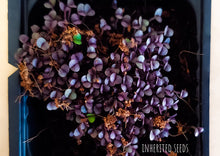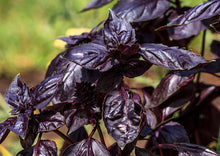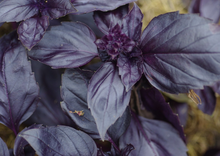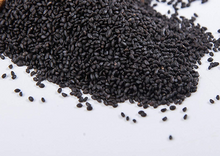
Heirloom Red Rubin basil is a stunning and flavorful addition to any garden. This unique basil variety is prized for its beautiful deep red leaves and spicy, aromatic flavor.
In addition to its good looks and great taste, heirloom Red Rubin basil is also packed with nutrients, antioxidants and vitamins.
In the kitchen, heirloom Red Rubin basil is a versatile ingredient that can be used in a wide range of dishes. Its spicy flavor pairs well with tomato-based sauces, grilled meats, and more. It is also a popular choice for making homemade pesto or for adding a pop of color to salads and other dishes.
Overall, heirloom Red Rubin basil is a beautiful and tasty addition to any garden or kitchen. If you're looking to add some visual interest and flavor to your meals, give this heirloom basil a try!
Today, heirloom Red Rubin basil is grown and enjoyed by people all over the world. It is a beloved heirloom variety that is sure to continue to be a popular choice among home gardeners and chefs for years to come.
High yielding combined ornamental and edible plant!
Planting
- Kickstart the seeds indoors 6 weeks before the last spring frost.
- Basil prefers warmer temperature, wait until the soil has warmed to at least 50°F (daytime and night time temperatures). Basil grows best when the outside temperature reaches 70⁰F.
- Basil prefers full sun and grows best in a location that gets 6 to 8 hrs of full sun daily. They do well in partial sun locations as well.
- Soil should be moist but well-drained. Basil grows well in containers or raised beds, as these allow for better drainage.
- Companion plants: Tomatoes make great companion for basil plants in the garden.
Care
- Basil plants like moisture, mulching helps cool the plant (during host days) and ensure even moisture.
- Pruning helps branches multiply and more harvest. Simply trim the tips after every six sets of leaves
- Every time a branch has six to eight leaves, repeat pruning the branches back to their first set of leaves.
Harvest
- Start picking the leaves of basil when the plants reach about 8 inches tall.
- Leaves are most flavorful before sunrise, harvest early morning for the best taste. Pick the leaves regularly to encourage growth throughout the summer.
Pests / Diseases
Root Knot Nematode: Galls on roots which can be up to 1 inch in diameter but are usually smaller; reduction in plant vigor; yellowing plants which wilt in hot weather.
Control / Prevention: Plant resistant varieties if nematodes are known to be present in the soil; check roots of plants mid-season or sooner if symptoms indicate nematodes; solarizing soil can reduce nematode populations in the soil.
Aphids: Yellow leaves; distorted flowers/fruit; sticky “honeydew”; sooty, black mold that forms on honeydew; large presence of ants on plants.
Control / Prevention: Grow companion plants to either repel aphids away; knock aphids off plants with water spray, apply insecticidal soap; put banana or orange peel around plants; wipe leaves with a 1-2% solution of liquid dish soap, water every 2-3 days for 2 weeks.
Leafminers: Thin, white, winding trails on leaves; heavy mining can result in white blotches on leaves and leaves dropping from the plant prematurely; early infestation can cause fruit yield to be reduced.
Control / Prevention: Check transplants for signs of leafminer damage prior to planting; remove plants from soil immediately after harvest; only use insecticides when leafminer damage has been identified as unnecessary spraying will also reduce populations of their natural enemies.
Flea Beetle: Numerous tiny holes in leaves.
Control / Prevention: Use row covers to physically block flea beetles; mulch heavily; add native plants to attract beneficial insect predators.
Click here to download our free vegetable growing guide










